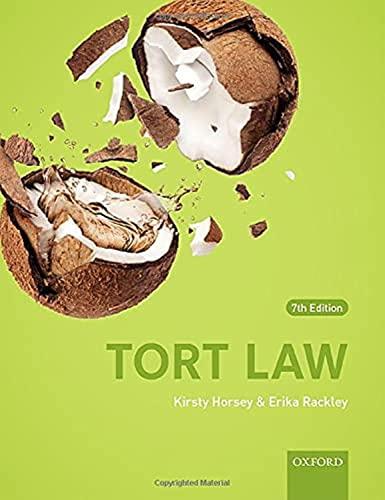Question
Carter and Johns were charged with conspiracy to commit a controlled substance crime in the first degree and aiding and abetting in a controlled substance
Carter and Johns were charged with conspiracy to commit a controlled substance crime in the first degree and aiding and abetting in a controlled substance crime in the first degree, in violation of Minn. Stat. 152.021, subds. 1(1), 3(a), 609.05 (1996). They moved to suppress all evidence obtained from the apartment and the Cadillac, as well as to suppress several postarrest incriminating statements they had made. They argued that Thielen's initial observation of their drug packaging activities was an unreasonable search in violation of the Fourth Amendment and that all evidence obtained as a result of this unreasonable search was inadmissible as fruit of the poisonous tree. The Minnesota trial court held that since, unlike the defendant inMinnesotav.Olson,495 U. S. 91 (1990),Carter and Johns were not overnight social guests but temporary out-of-state visitors, they were not entitled to claim the protection of the Fourth Amendment against the government intrusion into the apartment. The trial court also concluded that Thielen's observation was not a search within the meaning of the Fourth Amendment. After a trial, Carter and Johns were each convicted of both offenses. The Minnesota Court of Appeals
87
*87held that respondent Carter did not have "standing" to object to Thielen's actions because his claim that he was predominantly a social guest was "inconsistent with the only evidence concerning his stay in the apartment, which indicates that he used it for a business purposeto package drugs." 545 N. W. 2d 695, 698 (1996). In a separate appeal, the Court of Appeals also affirmed Johns' conviction, without addressing what it termed the "standing" issue.Statev.Johns,No. C9-95-1765 (June 11, 1996), App. D-1, D-3 (unpublished).
A divided Minnesota Supreme Court reversed,
ad1) What problems are we most likely to see at which stage of the business cycle?
2) Define opportunity cost.
3) With appropriate examples, define the difference between direct and indirect taxes.
4) Define "excess supply" and "excess demand" with respect to price.
5) Define "invisible hand".
6) True or False? In you focus on current global economic paradigms, has Adam Smith has been
taken out of context from his original text?
7) Which of the following can be derived from other assumptions of economics?
8) True or False. The additional cost to a producer of hiring an additional unit of labor is called
the marginal cost.
9) True or False. Monetarists believe the government should use monetary policy to boost
aggregate demand during a recession.
10) What is the current measure of growth?ditional qoestions
Step by Step Solution
There are 3 Steps involved in it
Step: 1

Get Instant Access to Expert-Tailored Solutions
See step-by-step solutions with expert insights and AI powered tools for academic success
Step: 2

Step: 3

Ace Your Homework with AI
Get the answers you need in no time with our AI-driven, step-by-step assistance
Get Started


